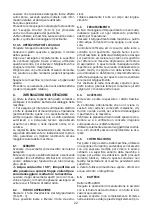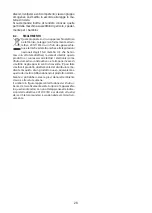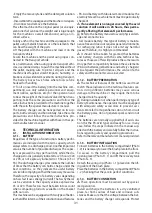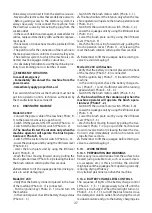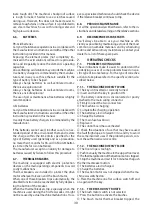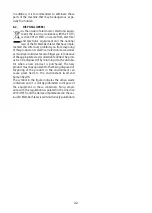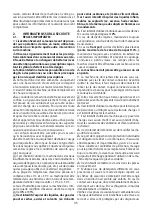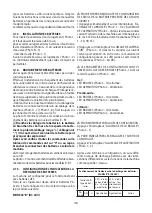
35
three LED’s: red, yellow and green, as in the whole
range of the battery chargers.
The green LED shows the end of the charging or the
last phase in case of deep charging process; in the for-
mer case, the relay is opened to disconnect galvani-
cally the battery from the battery charger.
•
For further information refer to the use and safety
manual of the battery charger provided by the man-
ufacturer.
If the machine is equipped with Pb-Acid batteries,
charge only in a well-ventilated area, lift the superior
cover and open the battery plugs.
•
Follow the steps indicated in the battery manufac-
turer’s operating and safety manual (see the battery
maintenance section).
If the machine is equipped with GEL batteries (mainte-
nance free), follow the instructions indicated here below.
If the machine is used regularly:
Always keep the batteries connected to the battery
charger when the machine is not being used.
If the machine is not used for extended time periods:
Charge the battery during the night after the last
work period, and then disconnect the battery from
the battery charger.
Charge the battery during the night before using the
machine again.
Intermediate or incomplete charging while working
should be avoided.
If the machine is equipped with Pb-Acid batteries, use
a hydrometer to check the element liquid intensity
on a regular basis: if one or more elements are dis-
charged and the others fully charged, the battery has
been damaged and should be replaced or repaired
(refer to the battery service manual).
Close the element plugs and lower the superior cover.
5.4.
SQUEEGEE ASSEMBLY
Slightly screw the two knobs ( Photo M - 6 ) into the
squeegee body and insert the squeegee into the slots
situated on the squeegee support.
Screw the two knobs ( Photo M - 6 ) in order to secure
the squeegee to the support.
Firmly insert the suction hose ( Photo M - 3 ) into the
pipe in the squeegee body.
5.5.
SQUEEGEE DISASSEMBLY
Disconnect the suction hose from the squeegee body.
Unscrew the two knobs ( Photo M - 6 ) that secure the
squeegee to its support and pull the squeegee to free it.
5.6.
SQUEEGEE BLADES DISASSEMBLY /
ASSEMBLY
Disassemble the squeegee from its support (see 6.5)
Unscrew the knobs ( Photo M - 4, Photo M - 6 ) placed
on the squeegee body and apply some pressure on
their bolts in order to push out the plastic support of
the squeegee blades from the squeegee body.
Tear off the rubber blades from the plastic support.
Assemble the new blades on the plastic support by
the means of the plastic pins that have to be fixed in
the holes placed the blades.
Push the plastic support of the squeegee blades into
the squeegee body and screw the knobs ( Photo M - 4,
Photo M - 6 ) to secure it to the squeegee body.
Reassemble the squeegee to its support (see 6.4).
5.7.
SQUEEGEE ADJUSTMENT
The knob screw on the squeegee support ( Photo M
- 7) adjusts the squeegee’s inclination with respect to
the floor. The two red knobs on the sides, connected
to the rear wheels of the squeegee ( Photo M - 2 ) are
to adjust the pressure of the squeegee to the floor.
When the squeegee is perfectly adjusted, the rear
squeegee blade, sliding as it moves, bends in all
points forming an angle of 45° with the floor.
As the machine operates (advances), the knobs ( Photo
M - 2, Photo M - 7 ) can be used to adjust the inclination
and pressure of the squeegee blades on the floor.
Squeegee drying must be uniform along the entire
drying line: damp patches mean that drying is insuffi-
cient; turn the adjustment knobs to optimize drying.
5.8.
SPLASH GUARD ASSEMBLY/
DISASSEMBLY
The splash guard is attached to the brush plate by in-
terlocking on the plastic cover.
To remove the splash guard is sufficient to pull it
down until it detaches from the plastic cover.
To replace the splash guard,push it into the bottom
edge of the plastic cover from one end and continue
pushing up to the other end.
5.9.
BRUSH ASSEMBLY / DISASSEMBLY
•
Never use the machine if the brush or the pad
holder with abrasive pad is not perfectly installed.
Assembly:
Make sure that the brush plate is raised; otherwise lift
it by following the instructions provided in the spe-
cific section.
Make sure that the ignition key on the control panel
is in OFF position.
Place the brush under the plate, taking care that the
coupling flange on the brush is under the metal cou-
pling of the machine.
Lower the brush plate and start the brush rotation
operating the brush motor switch and the brush op-
eration lever; the brush will couple automatically.
To assemble the pad holder follow the same procedure.
•
Do not allow the length of the rows of brushes to
become lower than 1 cm.
Summary of Contents for FREE EVO
Page 3: ...3 2 1 3 A B 6 1 3 4 5 2 E AC 230V...
Page 4: ...4 C D 2 2A 3A 3B 3C 1A 1 3 6 3 4 5 1 8 2 B DC 24V 7...
Page 6: ...6 H G 1 2 1 3 2 I...
Page 7: ...7 1 2 L M 1 1 4 4 3 2 5 7 6 5 2 6...
Page 8: ...8 N O 1 1 2 3 3 2 4...
Page 9: ...9 P 1...
Page 95: ...95 1 1 1 1 2 2 10 1 3 1 4...
Page 96: ...96 1 5 2 2 1 4 35 10 50 30 95 2 10...
Page 97: ...97 2 2...
Page 98: ...98 3 3 1 3 2 3 3 C C 3 4...
Page 99: ...99 4 4 1 4 1 1 20 20 20h 5 5 5h 5 5 20 20 24 4 1 2 4 1 3 I 2 G 1 3 I 1 I 2...
Page 104: ...104 5 4 M 6 M 6 M 3 5 5 M 6 5 6 6 5 M 4 M 6 M 4 M 6 6 4 5 7 M 2 45 M 2 M 7 5 8 5 9...
Page 105: ...105 1 1 5 10 50 C 3 4 2 2 2 P 1 5 11 3 1...
Page 106: ...106 5 D 6 F 7 3 5 12 AC 230V AC230 AC 230V 5 13 230V 1 1 ON 2 B 5 A 3 3 2 4 DC 24V D 7 D 1 3 1...
Page 108: ...108 6 11 6 6 1 50 6 2 M 3 6 3 6 4 6 5 6 6...
Page 109: ...109 6 7 6 8 6 8 1 6 8 2 6 8 3 6 9...
Page 110: ...110 7 7 1 7 1 1 1 C 30 7 1 2 5 7 1 3 7 1 4 7 1 5 7 1 6 7 1 7...
Page 111: ...111 7 1 8 7 1 9 7 1 10 100 20 30 8 12 8 1 2013 56 EU...
Page 112: ...112 8 2 2012 19 EU 2012 19 EU...
Page 130: ...130 8...
Page 131: ...131 7 3 12...
Page 132: ...132 6...
Page 133: ...133 5 2 10...
Page 134: ...134 4 4 35 10 50 30 95...
Page 135: ...135 3 5 1 CE CE 2 1 2...
Page 136: ...136 2 3 1 CE 4 1...
Page 137: ...137 1 1 1 1 1 2...
Page 153: ...153...
Page 231: ...231...
Page 247: ...247 1 1 1 1 2 2 10 1 3 a 1 4...
Page 248: ...248 1 5 2 2 1 4 C 35 C 10 C 50 C 30 95 2 10...
Page 249: ...249 2 2 3 3 1 3 2 3 3...
Page 250: ...250 3 4 4 4 1 Ah 20 C20 20h 5 C5 5h C5 C20 Pb Acid...
Page 255: ...255 1 Pb Pb 5 4 M 6 6 M 3 5 5 6 5 6 6 5 M 4 M 6 M 4 M 6 6 4 5 7 M 7 2 45 M 2 M 7 5 8...
Page 256: ...256 5 9 OFF 1 cm 1 cm OFF 5 10 L 50 C N 4 N 3 2 N 2 2 L Q 1 5 11 N 3 0 1...
Page 259: ...6 11 6 259 6 1 50 6 2 X X X X X X X X X X X X X X X X X X...
Page 260: ...260 3 6 3 6 4 6 5 6 6 BPb 3 AGM 6 6 7...
Page 261: ...261 6 8 6 9 7 7 1 7 1 1 ON 30 7 1 2 5 7 1 3 7 1 4 7 1 5 7 1 6...
Page 262: ...262 7 1 7 7 1 8 7 1 9 7 1 10 100 20 30 8 12...
Page 263: ...263 8 1 2013 56 8 2 WEEE 2012 19 2012 19 EU...
Page 265: ...265 1 1 1 1 2 2 2 10 1 3 1 4...
Page 266: ...266 1 5 2 2 1 4 C 35 C 10 C 50 C 30 95 2 10...
Page 267: ...267 2 2 134 3 3 1 3 2 3 3...
Page 268: ...268 3 4 4 4 1 4 1 1 Ah 20 C20 20h 5 C5 5h C5 C20 24...
Page 274: ...274 5 8 5 9 1 cm 1 cm 5 10 50 C N 4 N 3 G 2 N 2 2 cm 5 11...
Page 277: ...6 13 6 14 3 5 14 5 277 6 11 6 X X X X X X X X X X X X X X X X X X...
Page 278: ...278 6 1 50 6 2 M 3 6 3 6 4 6 5 6 6...
Page 279: ...279 3 AGM 6 6 7 6 8 6 9 7 7 1 7 1 1 1 30 7 1 2 5 7 1 3 7 1 4...
Page 280: ...280 7 1 5 7 1 6 7 1 7 7 1 8 7 1 9 7 1 10 100 20 30 8 12...
Page 281: ...281 8 1 2013 56 E 8 2 2012 19 2012 19...
Page 282: ......
Page 283: ......
Page 284: ......


